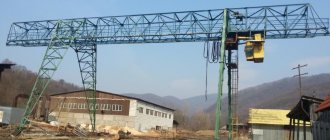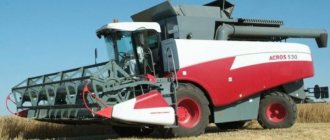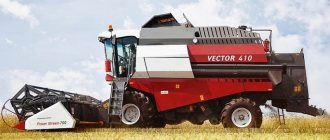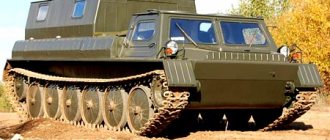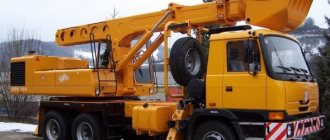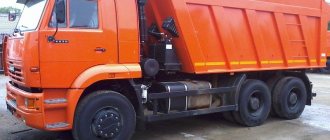Scope of application
Yenisei 950, the technical characteristics of which allow the equipment to be used for harvesting grain, legumes, cereal crops, sunflowers, and grasses, belongs to the 4th harvest class. The machine is used in medium-yielding and high-yielding fields. To carry out work with minimal losses, it is necessary to select the right attachments and configure them depending on the characteristics of the site and the type of harvest crops.
Yenisei-950 combine harvester at work
Design and service features
Yenisei KZS 950 is a fourth class self-propelled combine harvester. The chassis of the equipment has increased reliability. The drive wheels are fixed with flanges and equipped with pneumatic tires with low pressure. The model is equipped with a reinforced MVG-12 bridge, which is controlled hydraulically. The bridge itself consists of a beam, left and right axle shafts, gearbox, hydraulic motor, final drives and couplings. The final drives are equipped with disc brakes controlled by their own hydraulic drive. At the driven wheels, the bridge includes a lever-type steering linkage mechanism, due to which rotation is carried out, and a bridge beam connected by means of hinges to the shank of the threshing frame. Such a mechanism assumes free vertical movement. For stability, the beam is equipped with rubber swing stops, allowing you to move safely and comfortably over bumps and slopes.
Design of the Yenisei 950 combine
The harvesting process on the Yenisei 950 grain combine is performed in the same way as when using other machines of this type:
- the reel lifts the stems;
- the cutting tool cuts them off;
- the conveyor directs the mass to the threshing and separating device;
- the beater knocks the grain out of the ears;
- it falls through the cracks and moves along a screw conveyor into the grain bin;
- the straw is fed into the chopper and then out.
Improved coupling devices allow the Yenisei 950 combine harvester to be mounted with headers of various widths, which expands the functionality of the machine and allows for efficient harvesting with minimal losses:
Header of the Yenisei 950 combine
- narrow (5 m) – on difficult terrain and high-yield fields;
- wide (6–7 m) – on large areas of crops with a slope of up to 9 degrees.
Wide headers should not be used in high-yield areas, as the threshing drums do not have time to process the incoming mass, which leads to increased losses.
The operator's cabin is equipped with an air conditioning system that maintains a comfortable temperature in all weather conditions. Sound insulation provides an additional level of comfort. The location of the Yenisei 950 cabin in the center with a forward position gives a good overview of the conveyor and allows the operator to control the progress of work.
Arched wheels ensure high maneuverability of the equipment both on black soil and on sandy soils. There are 3 ways to place threshing equipment for processing grains and seeds of various crops.
Agreecultural machines. Agreecultural equipment
1.3.5 Hydraulic system
The hydraulic system consists of two independent systems: the main and steering hydraulic systems. A schematic diagram of the combine harvester hydraulic system is shown in Figure 1.11.
The main hydraulic system is designed to lift the header and reel, change the rotation speed of the reel, the first and second threshing drums, turn on the bunker unloading auger, move the unloading auger to the working and transport position, turn off the drive of the reaping part, clean the air intake, adjust the flaps of the bunker unloading auger, for reverse scrolling the threshing drums, engaging the threshing clutch, opening and closing the stacker. The hydraulic system provides for the possibility of horizontal reel extension.
The main hydraulic system includes a gear pump 21 (Figure 1.11), a pressure filter 27, a safety-unloading unit 28, plunger and piston hydraulic cylinders 2-26, hydraulic valves 17, 18, 19.
Pressure filter 27 ensures the necessary oil purity during operation.
To control all consumers of the main hydraulic system, three multi-section distributors 17, 18, 19 are used with a parallel spool connection circuit (three-section, four-section, five-section), connected in parallel to the pump pressure line.
To control the raising and lowering of the header and reel, and to change the reel rotation speed, a section with one shut-off valve is used.
A four-section distributor 19 installed on the bunker is designed to control: opening the bunker dampers, turning on the unloading auger, turning on the threshing apparatus, closing the stacker; for a combine with a chopper, a three-section distributor is used. For a two-drum combine with a stacker, a five-section distributor is used.
The three-section distributor 18, located on the right under the driver's platform, is designed to control: lifting - lowering, turning off the header, cleaning the air intake grids, and reverse rotation of the drum.
The five-section distributor 17, located on the left under the driver’s platform, is designed to control the hydraulic removal of the reel, the lifting of the reel, the variator of the first drum, and the translation of the folding auger.
The design of the hydraulic system provides for the possibility of connecting a pressure gauge to control pressure using a quick-release coupling 29.
The hydraulic valve section with electrohydraulic control and a double-acting hydraulic lock is shown in Figure 1.10.
The distributor housing 12 contains shut-off valves 2, electromagnets 1, channels and a spool 10. The spool has annular grooves, bands, radial and axial drillings, which house valve seats 8, a central sleeve 11 and rings. The spool is installed in the neutral position by springs 9.
When the electromagnets are turned off, cavities P (supply), A and D are connected to the discharge cavity (in the neutral position of spool 10 - unloading pressure); cavities B and C are connected to the drain.
When the key on the control panel is turned on, the circuit of the right electromagnet 1 is closed, the armature 3 is pulled inward, the unloading of the hydraulic distributor stops and working pressure is created in the cavities P, A and D. The flow of working fluid moves needle 7 all the way to the end of the armature, cavity A is connected to the drain. Due to the pressure difference in cavities A and D, the spool moves to the extreme right position. Cavity P is connected to cavity B, and cavity B remains connected to the drain. Under the pressure of the working fluid, valve 3 opens and oil enters the discharge cavity of the cylinder. At the same time, piston 4, moving to the left under the influence of pressure, mechanically opens valve 3 of the opposite shut-off valve and the working fluid from the drain cavity of the cylinder flows to the drain.
When the electromagnet is turned off, the spool under the action of spring 9 returns to the neutral position.
The section operates similarly when the left electromagnet is turned on.
Figure 1.10 — Hydraulic distributor section with electrohydraulic control:
1 - electromagnet; 2 - shut-off valve; 3 - valve; 4 - piston; 5 - spring; 6 — electromagnet armature; 7 - needle; 8 - saddle; 9 - spring; 10 - spool; 11 — bushing; 12 — body; A, B, C, D, R - cavities
Figure 1.11 — Hydraulic schematic diagram:
1 - hydraulic tank; 2 — reel removal hydraulic cylinders; 3 — hydraulic cylinder of the reel variator; 4 — reel lifting hydraulic cylinder; 5 — reel lifting hydraulic cylinder; 6 — hydraulic cylinder of the drum variator; 7 — hydraulic cylinder of the drum variator; 8 — hydraulic cylinder of the folding auger; 9 — hydraulic cylinder of the folding auger; 10 — hydraulic cylinder for reverse scrolling of the drum; 11 — hydraulic cylinder for turning off the header; 12 — hydraulic cylinders for lifting the header; 13 — hydraulic cylinder for opening the bunker dampers; 14 — hydraulic cylinder for turning on the threshing apparatus; 15 — hydraulic cylinder for turning on the unloading auger; 16 — hydraulic cylinder driving the air intake mesh cleaning mechanism; 17, 18, 19 — distributor; 20 — pump NSh-10; 21 - pump; 22 - valve; 23 — throttle; 24 - check valve; 25 — filter element; 26 — quick-release coupling; 27 — pressure filter; 28 — unloading and safety block; 29 — quick release coupling; 30 — hydraulic cylinders for opening the stacker; 31 — steering unit; 32 — hydraulic cylinder for turning wheels; 33.34 - quick release coupling
Unloading and safety block
The unloading and safety block is designed to unload the pump and limit the maximum pressure in the hydraulic system to a value corresponding to the valve setting value, in accordance with its hydraulic circuit.
The block diagram is shown in Figure 1.12.
Figure 1.12 — Schematic diagram of the safety and unloading block
The block consists of housing 1 (Figure 1.13), in which the main valve DN15 mm is installed, consisting of a sleeve 26, a valve 25, and a spring. A throttle 27 is installed in the valve 25. Inside the housing 1 there are channels for supplying and discharging working fluid. On the housing 1 there are control safety valves 18, 20 and a hydraulic distributor 15, which are attached to the housing 1 using studs.
The working fluid from the pump is supplied to channel P (main flow), while part of the working fluid (control flow) through the throttle 27 enters the valve cavity of the main valve and through the channels in the housings of the control valves 18 and 20 (including through the pressure cavity of the control valve valve 20) enters cavity P of hydraulic distributor 15.
In the absence of voltage on the electromagnets 16, the spool 13, under the action of the springs 10, is in the middle position and passes the control flow into the drain. In this case, the pressure behind valve 25 is equal to the pressure in channel T. Valve 25, due to the pressure difference across it, opens and passes the main flow from channel P to channel T with small losses.
When voltage is applied to electromagnet XI, spool 13 moves to the left and passes the control flow into the pressure cavity of control valve 20. Valve 6 is closed under the action of spring 23. In this case, a locked volume is created in the valve cavity of the main valve and valve 25 closes under the action of a spring. When the pressure in the cavity P of the block increases above the setting pressure of control valve 18, valve 6 compresses spring 23 and passes the control flow to the drain, while the pressure in the valve cavity of the main valve decreases and valve 25 opens, passing the main flow into channel T. The control flow passes through valve 20. In this case, valve 20 does not open, since it is set to a higher response pressure than valve 18.
When voltage is applied to electromagnet X2, spool 13 moves to the right and blocks the control flow, while the control flow passes through the pressure cavity of valve 20. When the pressure in the cavity P of the block increases above the setting pressure of control valve 20, valve 6 compresses spring 23 and passes the control flow to drain, while the pressure in the valve cavity of the main valve decreases and valve 25 opens, allowing the main flow into channel T.
The control flow passes through valve 20.
Figure 1.13 — Unloading and safety block:
1 - body; 2–5 — sealing rings; 6 - valve; 7 - bushing; 8 - plug; 9, 11, 28 — sealing rings; 10 - spring; 12 — emphasis; 13 — spool; 14 — body; 15 — hydraulic distributor; 16 - electromagnet; 17 — gasket, 18, 20 — control safety valves; 19 — cap; 21 - screw; 22 - nut; 23 - spring; 24 — body; 25 - valve; 26 — sleeve; 27 - throttle
Hydraulic cylinders
To limit the speed of movement of consumers, the fittings and hollow bolts have throttle holes designed to allow a certain amount of oil to pass through. The diameters of the throttle holes 23 are shown in the schematic diagram (Figure 1.11) of the hydraulic system.
Hydraulic steering system
The steering hydraulic system 3 is designed to facilitate driving the combine and includes a gear pump 20 (Figure 1.11), a metering pump 21 and a double-acting hydraulic cylinder 32.
The combine uses a hydrostatic steering system using a monoblock rotary metering pump AR-125-12.
The volumetric hydraulic steering system includes a gear pump NSh-10-3, a monoblock metering pump AR-125-12 (Figure 1.14) with a built-in distributor, safety and shock valves, a hydraulic cylinder and a system of rigid and flexible oil pipelines. The safety valve is adjustable to a pressure of 12.5 MPa.
Figure 1.14 — Steering unit AR-125-12 (NDO-125)
Using a volumetric hydraulic steering system, you can control the combine both by flow force (with the power pump running) and without flow reinforcement (with the power pump turned off or the engine not running).
A monoblock metering pump is mounted under the driver's platform and is mechanically connected to the steering wheel.
In the neutral position (Figure 1.15), the spool drain channels are connected to the housing drain cavity, and the oil from the pressure line flows through these channels to the drain.
Figure 1.15 — Hydraulic diagram of the AR-125-12 steering unit:
P—discharge (input); R - control hydraulic line, feed during right turn; L — control hydraulic line, feed during left turn; T - drain
When the shaft is turned to the right, the spool rotates relative to the sleeve, and the gold and ka drain channels overlap.
When the shaft turns to the left, the pressure cavity of the spool is connected to the rodless cavity of the hydraulic cylinder, and the rod cavity of the hydraulic cylinder is connected to the drain. The hydraulic cylinder rod extends, turning the wheels in the other direction.
When the shaft is turned to the right, with the pump not working, oil from the steering system through the drain line through the check valve, the pressure line enters the metering pump, and then flows through the channel into the spool cavity and into the rod cavity of the hydraulic cylinder.
The oil in the volumetric hydraulic steering system comes from the main hydraulic system tank common to both systems.
Oil tank
The oil tank with stand 8 (Figure 1.16) is installed on the platform behind the hood of the engine unit on the right side of the combine. The oil tank consists of two sections 1 and 2, connected to each other by bolts. Section 1 is used to fill the oil of the main hydraulic system and the volumetric hydraulic steering system, section 2 is used to fill the oil of the chassis drive.
The oil tank provides cooling of the working fluid, its cleaning and temperature compensation for volume changes.
Section 1 consists of a housing, inside of which a filter device is installed, an oil indicator 3, suction pipes 16, 17, a drain pipe 15, a storage tank with a detachable coupling half 7 and a breather 4.
The filter device consists of a filter glass 13, in which a filter element 12 and a bypass valve 14, and a magnet 9 are installed.
The filter element ensures filtration of the oil of the main hydraulic system and the volumetric hydraulic steering system. Filtration fineness 25 microns.
Bypass valve 14 serves to protect the filter element from destruction when clogged, by pouring part of the oil into the tank, bypassing the filter element. The opening value of the bypass valve is 0.2+0.05 MPa (2+ 0.5 kgf/cm2).
Figure 1.16 — Hydraulic tank of the main hydraulic system and hydraulic drive of the chassis:
1 — section of the main hydraulic system and hydraulic steering system; 2 — section of the chassis hydraulic system; 3 — oil level indicator, 4 — breather; 5 - rod; 6 — sight; 7 — storage tank with a detachable half-coupling; 8 — tank stand; 9; - magnet; 10 — pressure sensor; 11 — filling fitting; 12 — filter element; 13 — filter glass; 14 - bypass valve; 15 — drain pipe; 16 — suction pipe of the main hydraulic system; 17 — suction pipe of the hydraulic steering system; 18 — feed pipe of the hydraulic steering system; 19 — suction pipe of the hydraulic system; 20 - drainage pipe of the GTS system
If the oil pressure is greater than or equal to the setting pressure of this valve, then the filter element must be replaced; the pressure value is indicated by pressure sensor 10; if it is absent, a plug is installed on the tank.
Fitting 11 is used to fill oil into the hydraulic tank using a supercharger. Magnet 9 is used to catch small metal impurities. Breather 4 provides communication between the internal cavity of the hydraulic tank and the atmosphere and serves to clean the air entering the tank from mechanical impurities. Oil indicator 3 serves to visually monitor the level of working fluid in the tank. The amount of oil in the tank should be between the upper and lower marks on the tank body. Suction pipes of different heights are installed at the bottom of the tank. The suction pipe 16 of the main hydraulic system is moved in height using a rod 5 equipped with a sighting device 6, and is installed in such a way that the sighting device 6 coincides with the oil level in the hydraulic tank, which ensures minimal oil loss in the event of a leak in the main hydraulic system.
Volumetric hydraulic drive of the chassis
The drive wheel bridge of the Yenisei KZS-950 combines is equipped with a volumetric hydraulic transmission, which consists of a hydraulic pump 1 (Figure 1.17), a variable supply, a reversible one (with a feed pump 3 built into it), a hydraulic motor 2 of constant displacement, a hydraulic tank 4, a fine filter 5 with a vacuum gauge 6 to monitor the degree of clogging of the filter and oil cooler 7.
The hydraulic units are connected to each other by high-pressure hydraulic lines 8, 9, drainage hydraulic lines 10, 13, 14 and suction hydraulic lines 11,12.
The hydraulic transmission is made according to a closed circuit, the oil circulates through high-pressure hydraulic lines 8 and 9. Changing the pump supply (changing the speed of the machine) is carried out by a hydromechanical device connected by means of a cable 15 to the control handle located in the cabin.
A cylinder block is mounted on the splines of shaft 20, in which the plungers move in the holes. Each plunger is connected by a spherical hinge to a heel, which rests on a support located in the cradle. The cradle can change the angle of inclination under the action of the servo cylinder 19.
Figure 1.17 — Volumetric hydraulic transmission GST-90 L:
1 — main hydraulic pump; 2 — hydraulic motor; 3 — make-up pump; 4 — hydraulic tank, 5 — fine filter, 6 — vacuum gauge; 7 — oil radiator; 8. 14 - 1 hydraulic line, 15 - control cable, 17 - safety valve of the sub-hatch pump; 18 — check valve, 19 — servo cylinder; 20 - pump shaft; 21 - cradle; 22 — hydraulic distributor; 23 — control lever; 24 — hydraulic motor shaft; 25 — inclined washer; 26 — valve box spool, 27 — overflow valve; 28 — high pressure valves; 29 — attached bottom; 30 - distributor
Together with the cylinder block, the attached bottom 29 rotates, sliding along the distributor 30. Leaks from the interface of the units enter the internal cavity of the hydraulic units, drainage leaks are discharged from the hydraulic motor housing 2, along the hydraulic line 10 into the pump housing 1, and from there, along the hydraulic lines 13, 14 through the radiator 7 - into the hydraulic tank.
To compensate for leaks and create the necessary excess pressure in hydraulic lines 8 and 9, a gear hydraulic make-up pump 3 is used. Oil from the hydraulic tank 4 via hydraulic line 12, through a race filter 5 and hydraulic line 11, enters the make-up pump 3 and is pumped into hydraulic lines 8 and 9. The hydraulic system includes valves and switchgear built directly into the pump and hydraulic motor. Adjustment and testing of their operation is carried out on specially equipped stands in stationary conditions.
The maximum operating pressure in high-pressure hydraulic lines is 35 MPa (350 kgf/cm2), and the make-up pressure is 1.5 MPa (15 kgf/cm2).
Technical characteristics of Yenisei 950
The Yenisei 950 grain combine is fully adapted to Russian climatic conditions and is distinguished by high productivity and economical fuel consumption (compared to Western analogues).
Main technical characteristics:
Scheme of the Yenisei 950 combine harvester
- overall dimensions (length, width, height) – 10*5*4 m;
- weight – 10.5 t;
- grain bin volume – 5 cubic meters. m;
- throughput – 8 kg/sec (or 100 t/8 h);
- specific fuel consumption per volume of processed grain (cut mass) – 8.2 (7.9) kg/t;
- fuel tank volume – 300 l.
The machine demonstrates its greatest efficiency during direct combining, when at least 85% of the grain has reached the required degree of maturity. It is also possible to use the Yenisei 950 combine to harvest the crop using the separate combining method - first, the stems are mowed, then, after 3-4 days, threshing is done using a mounted stripper.
Cleaning scheme for the Yenisei-950 combine
The hydraulic system regulates the main components of the machine: the transmission, the position of the header, the operation of the wheels and the unloading auger. The gearbox is equipped with a locking system, which prevents the engine from starting when the speed is on or the simultaneous engagement of two gears.
The designers have minimized the use of unique components and assemblies, which significantly increases the maintainability of the machine. It is allowed to use spare parts from other domestic combines, with the exception of drive belts - these parts are designed for a certain load.
An important operating condition is low humidity. At elevated values, the machine cannot cope with the load and requires regular manual cleaning. In addition, heavy wet straw falls along with the grain through the deck cracks, which increases the contamination of the crop and requires additional cleaning work.
Not available:
| № | Part code | Name | Part Information |
| 2602-3829 | Oil pressure warning sensor | Quantity 1 Note for YaMZ | Not available |
| PF-23 | Flashlight | Quantity 1 | Not available |
| 227-3711 | Right headlight low and high beam | Quantity 1 Note right | Not available |
| 157-3711 | Right headlight | Quantity 1 | Not available |
| 156-3711 | Left headlight | Quantity 1 | Not available |
| 226-3711 | Low and high beam headlight | Quantity 1 Note left | Not available |
| PF-23A | Front left lamp | Quantity 1 | Not available |
| 227-3711 | Right headlight low and high beam | Quantity 1 Note right | Not available |
| 157-3711 | Right headlight | Quantity 1 | Not available |
| 156-3711 | Left headlight | Quantity 1 | Not available |
| 226-3711 | Low and high beam headlight | Quantity 1 Note left | Not available |
| Socket | Portable lamp socket | Quantity 1 | Not available |
| P150-05-17 | Switch | Quantity 1 | Not available |
| FP2-12 | Flashlight | Quantity 1 | Not available |
| 6612-3709 | Turn switch | Quantity 1 | Not available |
| 522-3730 | Wiper motor | Quantity 1 | Not available |
| BD-1 | Diode block | Quantity 1 | Not available |
| BD-1 | Diode block | Quantity 1 | Not available |
| Electric hydraulic distributor | Electric hydraulic distributor | Quantity 1 | Not available |
| S302D | Sound signal | Quantity 1 | Not available |
| 2202-3803-28 | High beam warning lamp | Quantity 1 | Not available |
| 2202-3803-07 | High beam warning lamp | Quantity 1 | Not available |
| Air conditioner | Air conditioner | Quantity 1 | Not available |
| P147-03-17 | Wiper switch | Quantity 1 | Not available |
| PU950-03-2 | Remote Control | Quantity 1 | Not available |
| 92-3709 | Header lift/lower switch | Quantity 1 | Not available |
| 92-3709 | Header lift/lower switch | Quantity 1 | Not available |
| S303D | Sound signal | Quantity 1 | Not available |
| Electric hydraulic distributor | Electric hydraulic distributor | Quantity 1 | Not available |
| PP-E950-062 | Instrument panel | Quantity 1 | Not available |
| 0028-023714 | Cabin light | Quantity 1 Coated uncoated | Not available |
| PrP-1M | RPM sensor | Quantity 1 Speed Note | Not available |
| VK12-B | Switch | Quantity 1 | Not available |
| 30-3711 | Headlight assembly | Quantity 1 | Not available |
| VK2-A2SH | Switch | Quantity 1 Parking brake note | Not available |
| Heater | Heater | Quantity 1 | Not available |
| PrP-1M | RPM sensor | Quantity 1 Note of revolutions of the 1st drum | Not available |
| DO13-1M | Sensor | Quantity 1 Flap opening note | Not available |
| DO13-1M | Sensor | Quantity 1 Full shutdown note | Not available |
| PrP-1M | RPM sensor | Quantity 1 Note of revolutions of the 2nd drum | Not available |
| Sensor | Sensor | Quantity 1 Air conditioning receiver note | Not available |
| coupling | A/C compressor clutch | Quantity 1 | Not available |
| BD-1 | Diode block | Quantity 1 | Not available |
| Electric hydraulic distributor | Electric hydraulic distributor | Quantity 1 | Not available |
| BD-1 | Diode block | Quantity 1 | Not available |
| 30-3711 | Headlight assembly | Quantity 1 | Not available |
| VK2-A2SH | Switch | Quantity 1 Hopper filling note | Not available |
| 30-3711 | Headlight assembly | Quantity 1 | Not available |
| DO13-1M | Sensor | Quantity 1 Note of working position w | Not available |
| PrP-1M | RPM sensor | Quantity 1 Note revolutions oscillatory | Not available |
| PrP-1M | RPM sensor | Quantity 1 Note fan speed | Not available |
| PrP-1M | RPM sensor | Quantity 1 Note revolutions of grain w | Not available |
| PrP-1M | RPM sensor | Quantity 1 Note rpm | Not available |
| GSTTM100-V | GST oil temperature sensor | Quantity 1 | Not available |
| Terminal | YaMZ engine oil filter clogging indicator terminal | Quantity 1 | Not available |
| 3702-3829 | Pressure alarm sensor | Quantity 1 Note for D442-59 | Not available |
| 132-3839600 | Air cleaner clogging indicator sensor | Quantity 1 Model 132 Group Devices Subgroup Fluid level sensor Part number 600 | Not available |
| PrP-1M | RPM sensor | Quantity 1 Note beater revolutions | Not available |
| 1300-3737 | Ground switch | Quantity 1 | Not available |
| PN1402-3759-8 | Voltage transformer | Quantity 1 | Not available |
| 738-3747-30 | Starter relay | Quantity 1 | Not available |
| 4053-3771-76 | Generator | Quantity 1 Note for D442-59 | Not available |
| 4058-3771-49 | Generator | Quantity 1 Note for YaMZ | Not available |
| 25-3708-01 | Starter (for YaMZ-236 engine) | Quantity 1 Note for YaMZ | Not available |
| AZJ3367 | Starter | Quantity 1 Note for D442-59 | Not available |
| ST142B1 | Starter | Quantity 1 | Not available |
| TM100-V | Sensor | Quantity 1 | Not available |
| Sensor | Sensor | Quantity 1 Note crankshaft revolutions | Not available |
| PrP-ZM | Engine speed sensor | Quantity 1 | Not available |
| 6ST-190AP | Battery | Quantity 1 | Not available |
| 6ST-190PM | Rechargeable battery | Quantity 1 | Not available |
| 6ST-190TM | Rechargeable batteries | Quantity 1 | Not available |
| Sensor | Sensor | Quantity 1 Note of pressure blockage | Not available |
| ICRN | Pressure filter clogged sensor | Quantity 1 | Not available |
| RPB | Safety and unloading block | Quantity 1 | Not available |
| FG-16E | Turning headlight | Quantity 1 | Not available |
| KDM2-140 | Switch | Quantity 1 | Not available |
| PF-33 | Flashlight | Quantity 1 | Not available |
| PrP-1M | RPM sensor | Quantity 1 Note drum shaft revolutions | Not available |
| VK2-A2SH | Switch | Quantity 1 Note for hammering sol keys | Not available |
| FP2-12 | Flashlight | Quantity 1 | Not available |
| 30-3711 | Headlight assembly | Quantity 1 | Not available |
| FP131A | License plate light | Quantity 1 | Not available |
| PF-33 | Flashlight | Quantity 1 | Not available |
| 12N | Trailer socket | Quantity 1 | Not available |
| VK2-A2SH | Switch | Quantity 1 Emergency fill note | Not available |
| VK2-A2SH | Switch | Quantity 1 Note normal filled | Not available |
| VK2-A2SH | Switch | Quantity 1 Note for opening the stacker | Not available |
| VK2-A2SH | Switch | Quantity 1 Note of harvesting | Not available |
| VK2-A2SH | Switch | Quantity 1 Note for closing the stacker | Not available |
Combine engine
Engine of the Yenisei 950 combine
The Yenisei 950 grain harvester is equipped with a specially designed power unit. The car has a diesel engine without turbocharging, with a direct injection system. For cooling, two oil and one water radiators are provided. Relatively low power of 185 hp. With. is compensated by its uniform distribution across all mechanisms.
Multifunctionality, high performance, unpretentiousness and reasonable price are the main reasons for the demand for the machine. The combine is equally effective at harvesting grains, legumes and grass crops, so it can be the only universal machine for a small farm. Choosing the correct cutting width for the header reduces fuel consumption and ensures the highest labor productivity and minimal grain loss.
Related video: Review of the Yenisei 950 combine
Publications on the topic
Overview of the capabilities and technical characteristics of the Akros 530 combine harvester
Technical characteristics of the KZS-1218 combine
Description of the technical characteristics of the Vector 410 combine
INTRODUCTION
Harvesting is the final operation in the technology of cultivating agricultural crops.
The harvesting period for grains, cereals and leguminous crops is limited by agrotechnical periods of 6–7 days from the beginning of full ripeness of the grain. Even more stringent requirements are imposed on harvesting rapeseed and other easily shed crops. In the structure of the total costs of cultivating agricultural crops, harvesting takes up to 50% of energy costs and 45–60% of labor costs. The existing combine harvester fleet in Russia includes mainly domestic machines from the Rostov and Krasnoyarsk combine plants (Don-1500B, RSM-142 “Acros”, RSM-181 “Torum”, RSM-101 “VECTOR”, KZS-950 “Yenisei”).
The advantage of modern combines such as “Acros” and “Torum” is their highest productivity. Their average seasonal production is 1250 and 2000 hectares, respectively.
To achieve the effective use of combines, highly qualified specialists are needed who must have a good knowledge of the structure and principle of their operation, technological adjustments, operating rules, and identify and eliminate possible malfunctions that arise during their operation.
Practical information on these issues is presented in this manual. Modern domestic mass-produced combines were taken as objects of study.

